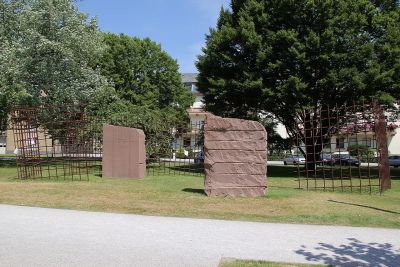Constricted remembrance: The graveyard with the memorial to the Soviet victims of the Nazis at the Mainz-Mombach Waldfriedhof
The largest collective grave for victims of the Nazis in the region
Outside Mainz, between the Mainz district of Mombach and the town of Budenheim west of there, lies the Mombach Waldfriedhof, which borders on the Lennebergwald. Only a few people know that the largest collective grave for victims of the Nazi era in the region, with more than 3,300 bodies, can be found in this idyllic location away from the hustle and bustle of the town. Who were these people of various heritages who were reinterred there at the western edge of the Waldfriedhof after the Second World War? The fact that the location of the Waldfriedhof was itself the scene of crimes has almost been forgotten: On 19 March 1945 – Mainz was liberated by American troops on 22 March 1945 – the SS shot 31 Soviet forced labourers, who their murderers no longer considered able to work or considered them too weak. After the war, another 41 individual graves were found.[1] At the site, there is nothing to show that these crimes occurred, but the graveyard with its memorial is still a place of remembrance. However, this remembrance is somewhat constricted when it comes to the origin of the victims; the historical complexity is not taken into account.
The dead in the Waldfriedhof
After the Second World War, looking after displaced persons, mostly former prisoners of war and forced labourers, was one of the most pressing assignments of the French military administration. In this context, it was also extremely important to record those foreigners who had died and been buried in Germany as completely as possible:
“To this end, the French Tracing Service had the foreigners who were buried in the German cemeteries exhumed in order to determine the identity of those who were buried, and they ensured that the dead received a dignified burial. This was a costly and time-consuming undertaking which took several years because the German cemetery administrations had buried the majority of the deceased foreigners […] away from the other grave sites and more importantly without coffins and they therefore had to be moved for reinterment and put in coffins.”[2]
During this time, a lot of effort went into facilitating appropriate grave maintenance, and to merging the Soviet burial sites, which were spread out among local cemeteries in the French occupied zone.[3] The Mombach Waldfriedhof is one of the main sites in the region of what is today Rhineland-Palatinate. This is because up to 1950, the French administration, as is stated below on the page of the Institut für Geschichtliche Landeskunde an der Universität Mainz e. V., “had around 3,330 deceased Soviet prisoners of war and forced labourers and their children, as well as the mortal remains of a series of Poles and Czechs from throughout Rhineland-Palatinate moved and reburied”.[4] For the women, men, children and young people, “hard working and living conditions, […] exhaustion, hunger, illness, abuse or bomb attacks”[5] were named as the cause of death, although executions also have to be assumed to be another cause.


